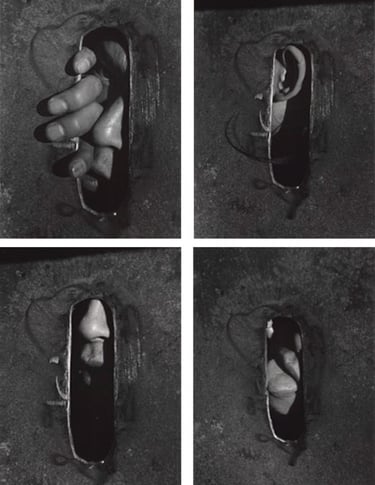In Dialogue With Photography and Performance Art
Iris Yirei Hu
3/24/2011


In response to a rapidly changing China, a group of avant-garde artists settled in Beijing’s East Village in an effort to cultivate self-expression. In particular, the artist Zhang Huan challenged and transcended his physical and mental limits of endurance through body art. His raw and provocative edge has granted him international recognition, but if it were not for Rong Rong, an East Village artist who documented his performances and many other happenings, little would be known about him. Rong Rong recorded many of Zhang Huan’s performances, immortalizing them through his own subjective lens. Rong’s Zhang Huan in Metal Case #1-4 is the only record of Zhang’s performance of Cage, in which Zhang locked himself in an eighty-by-eighty centimeter iron box for twenty-four hours. Through this work, he attempted to challenge the limits of endurance and meditation (Zhang, Chiu, Bu, and Heartney 2007, 62). However, because of the performance’s temporal and kinetic qualities, there was absolutely no way of documenting the whole experience. Instead, Rong’s snapshots of the performance ultimately constructed new interpretations of Zhang’s piece. Though Zhang’s actual performance remains hard to understand due to its ephemeral qualities, Rong’s photographs, however subjective and restrictive they are, allow one to digest the intentions of the work governed by the evidence he provides.
Four different photographs of Zhang Huan in a metal case are positioned in the structure of a grid, where each picture is deliberately placed in a coordinate plane’s quadrant. The grid is an orderly system as it is commonly used in mathematics, science, and urban planning. In Rong’s work, the photographs are democratically related, flattened, and ordered (Krauss 1985, 9). The grid unifies the photographs and does not emphasize any one picture over another since one looks at the grid as a whole. As opposed to a linear arrangement of photographs, where one would be inclined to read the images from left to right (or vice versa) or from top to bottom, the grid eliminates the possibility of a linear narrative by unifying the four pictures. The regularity of the grid confines the photographs into one entity, mimicking Zhang’s own solitary confinement in the metal box. At the same time, the rigid structure erases the organic nature of Zhang’s performance and shifts the work into a flat surface devoid of any action. Thus, the work becomes very much about the photographs, and not so much about the performance. Rong shares moments of Zhang’s performance through photographs, creating an illusion of what happened.
The illusion is highlighted by the photographs’ technical elements. First of all, the use of black and white photography—perhaps for its affordability and accessibility—evokes the past. It is temporal, signifying memories. Because reality is experienced in color, the black and white photographs, in this case, creates even more of an illusion when compared to color photographs. In essence, these photographs are flat and illusory representations of reality. The photographs’ flat surface reveals the inability to fully experience Zhang’s performance because one can only digest moments of it using Rong’s snapshots. The photographs justify that the performance exists beyond the scope of the picture plane, and therefore cannot be fully represented in four pictures. Furthermore, the photographs’ lighting evokes ominous psychological responses. The case’s surface is brightly lit by a fixed light source. However, the light is unable to penetrate through the opening, which ultimately creates a black void. While Zhang reveals parts of his body behind the opening, his features are obscured by light and shadows. The stark contrast between shadows and highlights evokes mystery and unease, which also suggests a cynical attitude. Through the mere choice of lighting and black and white photography, Rong is already able to control the viewers’ perception; he dominates the interpretation of Zhang’s performance. Thus, the technique, the contextual evidence, is as significant to interpreting the photographs’ content.
Furthermore, the composition of each photograph informs the content of the work. Rong emphasizes Zhang’s presence by framing the dark opening in the center of the shot, which is where Zhang reveals parts of himself. Framed in the center, Zhang’s presence is loud and frank, and becomes the sole focus. To support him, the composition is repeated and kept more or less consistent throughout the body of photographs. The static composition allows one to focus on the photographs’ only kinetic quality, Zhang’s body, while also emphasizing the unbreakable presence of the metal case. Moreover, the shots’ close-up nature indicates the personal and intimate relationship between Rong and Zhang. There seems to be a comfortable line between the two, as neither appears remotely apprehensive about photographing or being photographed. As Zhang allows Rong into a vulnerable space, which is seamlessly captured in the photographs, Rong, in turn, invites viewers into the space as well. By noting the bare context around the main subject matter, one is already able to discern multiple layers of meaning behind the work.
Zhang’s performance is an example of artists in need for self-expression; it is contrary to the image China wants to promote. Upon the uprising of the June Fourth Movement, avant-garde art was completely banned (Wu 2004). Using his body as the source of this performance, Zhang attempts to “challenge the limit of [his] endurance and meditation” by locking himself in an eighty-by-eighty centimeter box for twenty-four hours (Zhang, 62). The metal case is a metaphor for China’s authoritarian regime. It is indestructible by human force, and its durability represents the almighty power of the Chinese government. Locked inside, Zhang reveals different parts of his body through a small opening on one side of the case. Though his face is partially obscured in the upper left image, a menacing scowl is revealed on his face, but he is seemingly impotent. He is vulnerable and defensive. Well aware of his restrictions, he seems timid and scared to look at the camera, but communicates a desire to be free. As his fingers cling onto the edge of the opening, he suggests an urge to experience the world beyond the manmade metal enclosure. In the upper right, Zhang reveals his left ear to show that he is hearing and listening to the outside world. However, his ear is both obscured by shadow and illuminated by uneven lighting, creating a juxtaposition of the two that is very stark. On the one hand, the shadow cast on the ear is the physical manifestation of darkness in the container that he is in, which serves to remind the viewer that he is stuck in this box. On the other hand, the lighting directed on parts of the ear implies that he is yearning to be free despite his constraints. In the bottom left, Zhang’s nose and mouth suggest the need to breathe and smell the world outside, and in the last photograph, he finally tastes the rim of the opening. By tasting the opening’s rim, he implies that his ability to comprehend the open space beyond the metal case is limited, representing the lack of mobility in contemporary China. The metal case is an obstacle to experiencing freedom, as he is only able to see outside through an opening, which doubles as a peephole. He is unable to participate or integrate with the outside world; he is a passive voyeur. Zhang Huan in Metal Case shows Zhang’s investigation of his surroundings using his body and senses, and even further, represents Zhang’s internal struggles with China’s limitations and restrictions. For Zhang, his body is the physical proof of his existence and identity.
Initially seen as documents of the performance, the images innately reveal Rong’s subjective imposition. Documentation is, in an ideal situation, an objective truth. However, by now one understands that this is hardly ever the case. In deciding how a picture should look, the photographer inherently imposes his own standards on the subject, which in this case, is Zhang Huan (Sontag 1977, 5). As the photographer, Rong is immediately in the position of power; he controls the viewers’ gaze and limits interpretations of the work according to his own standards. Moreover, he “[converts] experience into an image,” and strips the performance of its “liveness” (Sontag 9). But because of performance art’s temporal and kinetic qualities, it is difficult and arguably impossible to document the entirety of the performance. Thus, the documenter’s subjectivity comes into play and ultimately dominates the performance’s interpretation, as seen through this work. However, because photography has the power to justify an event that happened, it legitimizes an event not everyone was there to witness. In this case, Rong’s record of Zhang’s performance confirms the performance’s existence. Though its ephemeral nature remains untranslatable, glimpses of it has been immortalized by photography. Nevertheless, because Rong’s records are the only documents of this particular performance, one is forever subjected to understanding Zhang’s performance through Rong’s personal interpretation of it.
Though documented by Rong Rong, little is actually known about Zhang Huan’s performance of Cage. Wu Hung writes that Zhang “tries to experience death” through this performance, and in Zhang’s own words, he says, “Being alive is the most important. Life is the priority” (Wu 1999, 106; Zhang 64). In many respects, Zhang’s performance is a metaphor for his internal struggle against China’s severe economic conditions. As seen from the way the work is positioned on the wall—in a grid structure—to the framing of the photographs, one can interpret this piece as a yearning to experience a world unknown. Embedded in the photographs are political intentions regarding China’s political and social policies. Artists were not, and still are not, free to express themselves, and to this day, people still lack freedom of speech. On an art historic level, this work is an exemplar of the long and historic debate on issues in documentary photography. Though the pictures serve as the performance’s primary documents, the photographer’s conscious and subconscious decisions of image construction reveals his personal sentiments. In this sense, the photographs not only suggest Rong’s subjective vision, they also imply his personal connection to the performance he witnessed and later digested. By selecting these specific records and unifying them into one work, they too, reveal Rong’s own idealization of a world without limitations. In that case, Rong’s work is not only a mere documentation of Zhang’s performance; its self-sustaining qualities constitute an artwork in itself.
Bibliography
Krauss, Rosalind E., “Grids,” The Originality of the Avant-garde and Other Modernist Myths, Cambridge, MA: MIT, 1985.
Sontag, Susan, On Photography, New York: Farrar, Straus and Giroux, 1977.
Wu, Hung, “Between Past and Future: A Brief History of Contemporary Chinese Photography,” Between Past and Future: New Photography and Video from China, 2004, 11-36.
Wu, Hung, Transcience: Chinese Experimental Art and the End of the Twentieth Century, Chicago: Smart Museum of Art, The University of Chicago, 1999.
Zhang, Huan, Melissa Chiu, Kong Bu, and Eleanor Heartney, Zhang Huan: Altered States, New York: Asia Society, 2007.
